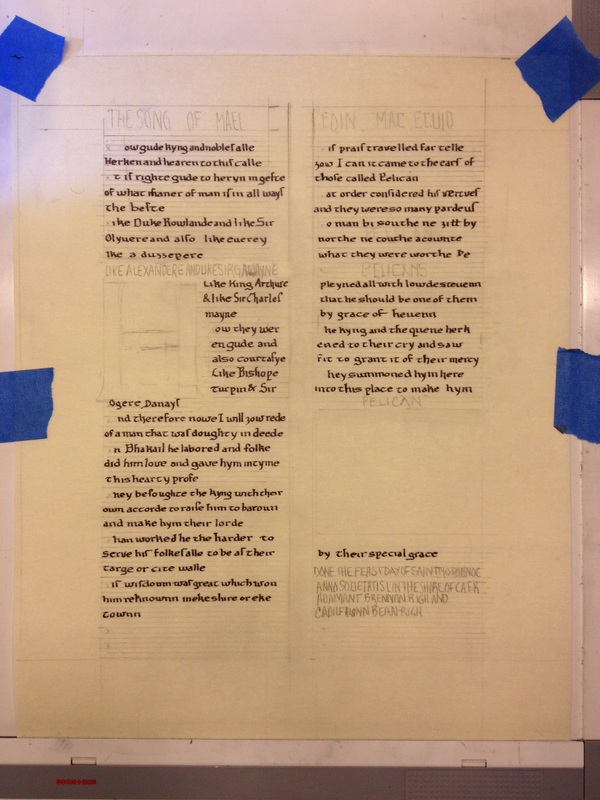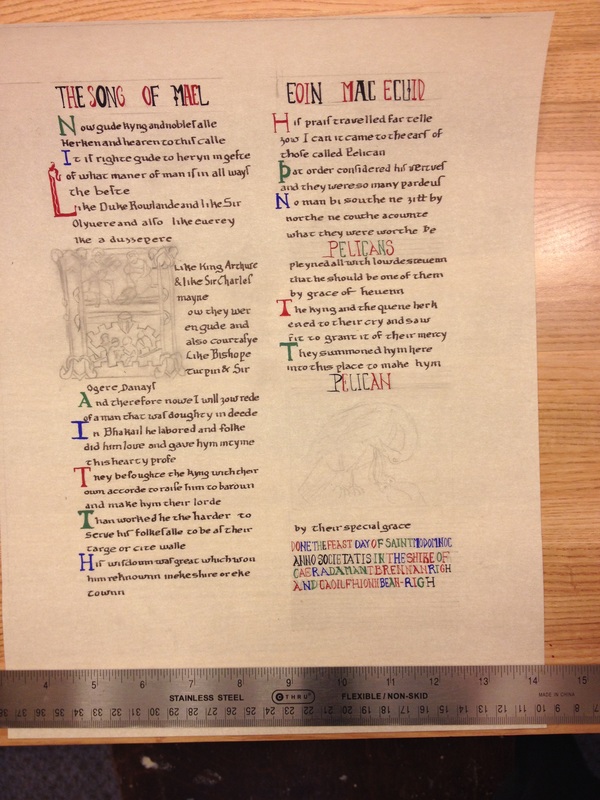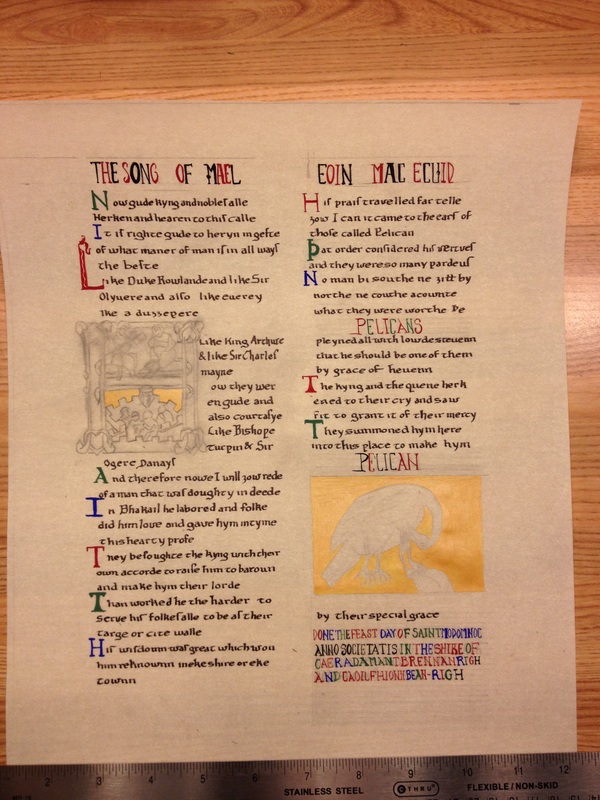I sent out emails to Alys for suggestions on what Mael Eoin might like, and she sent me some ideas. I also contacted Alexandre Lerot d'Avigne, who is Mael Eoin's Pelican, to see if he would be willing to do the words. He was and had some thoughts on the scroll choice. So while I began researching, Alexandre started working on the words. They were beautiful words, with Alexandre asking how my Middle English use of thorns was.... :-)
Wording, research and notes from Alexandre.
THE SONG OF MAEL EOIN MAC ECHUID
1 Now gude kyng and nobles alle
Herken and hearen to this calle
It is righte gude to heryn in geste
Of what maner of man is in all ways the beste,
5 Like Duke Rowlande and like Sir Olyuere,
And also like euereylke a duȝȝepere.
Like Alexandere and like Sir Gawayne,
Like King Arthure & like Sir Charlemayne,
How they weren gude and also curtasye,
10 Like Bischope Turpyn & Sir Ogere Danays.
And therefore nowe I will ȝow rede
Of a man that was doughty in dede.
In Bhakail he labored and the folke did him lufe
And gave hym in tyme this herty profe:
15 They besoughte the kyng with their own accorde
To raise him to baroun and make hym their lorde.
Than worked he the harder to serve his folkes alle
To be as their targe or cite walle.
His wisdoum was great which won him reknownn
20 In eke shire and eke townn.
His praise travelled far, telle ȝow I can,
It came to the ears of those called Pelican.
Þat order considered his vertues
And they were so many pardeus
25 No man bi southe ne ȝitt by northe
Ne couthe acownte what they were worthe.
Þe Pelicans pleyned all with lowde steuenn
That he should be one of them by grace of heuenn.
The kyng and the quene herkened to their cry
30 And saw fit to grant it of their mercy.
They summoned hym here into this place
To make hym Pelican by their special grace.
Done the feast day of Saint Modomnoc anno societatis L in the Shire of Caer Adamant.
Brennan Righ and Caoilfhionn Bean-Righ.
Words by His Highness Alexandre Lerot d’Avigne
Calligraphy and Illumination by: Natalia Anastasia Fortuna (ne Nataliia Anastasiia Evgenova)
RESEARCH
Wording Inspired by (and containing some phrases lifted directly from) the romance of Richard Coeur de Lion, c. 1300. http://www.middleenglishromance.org.uk/mer/45 The edition I'm using is an unpublished thesis by Dr Cristina Figeuredo. - Alexandre d'Avigné/Jeff Berry, 2 Jan 2016
FOR THE HERALDS – TO HELP WITH PRONUNCIATION
Pronunciation -
This is down and dirty, and if the herald speaks Middle English probably unnecessary.
Generally the yogh (ȝ) takes a 'y' sound - ȝow -> you or yow.
Thorns (Þ) take a 'th' sound - Þe -> the.
Usually a terminal e has an unstressed vowel sound, a schwa. 'rede' becomes 'REED-uh'.
A lot of the v's are spelled with u's. steuenn->stevenn, etc.
Specific vocabulary and pronunciation notes by line are below -
3 geste; heroic tale
6 duȝȝepere; the (French?) twelve peers. This may be a unique usage, as the word does not appear in the Middle English Dictionary. I suspect it is pronounced with the double yogh giving a 'z' sound so that duȝȝe sounds like the French douze for 12.
13 lufe; love
14 profe; proof
18 targe; a shield
24 pardeus; by God.
27 steuenn; voice
Lines 5-10 are taken almost verbatim from Richard Coeur de Lion lines 11-16, with a bit cribbed from earlier. Lines 5-16 are:
It is righte gude to heryn in jeste
Off his prowesche and his noble conqueste.
Also full fele romance men makis nowe,
Of gude knyghtis Þat were stronge & trewe,
Of Þaire dedis men redys romance
Bothe in Yglonde and eke in Fraunce:
Of Duke Rowlande and of Sir Olyuere,
And also of euereylke a duȝȝepere.
Of Alexandere and of Sir Gawayne,
Of Kyng Arthure & of Sir Charlemayne,
How they weren gude and also curtayse,
Of Bischope Turpyn & Sir Ogere Danays.
Lines 25-26 are verbatim lines 2087-2088
I used spelling from the romance whenever possible.
Now for the Illumination part!
I then started researching through the suggestions that Alys sent to me, and decided that the calligraphy and illumination based on the Winchester Bible, MS 17, a Romanesque illuminated manuscript produced between 1160 and 1175 in Winchester, England would do the trick. I needed a Pelican to match this, so researching again.
Original source material here:
With further research here and here.
Pelican research: Here was one example,
Another
Both of which were French, which was close.
The one I eventually chose from Flanders.
More information on it
My main difficulty was matching a Pelican example that was early enough and in England. The one in Flanders was aesthetically more pleasing to me so I eventually went for that. It came from the Grootseminarie Brugge, MS. 89/54, (Ter Duinen Aviary), Flanders, ca. 1190-1200.
I printed up all the examples and posted them as references.
I also used Opaline Vellum for the first time. Opaline Vellum is a processed material made from real vellum. This is a step up from using Pergamenata (which is vegetable pulp based paper, translucent and closer to the feel of real vellum), to a paper that is processed with vellum pulp, but less expensive than Vellum. I liked working with it, but I may need to do some side by side comparisons to really see the difference.
I liked working on an earlier time period illumiation than I am used to, and my calligraphy is slowly improving. I would like to do more general research when I am not under the gun to make up a bank of examples. I also am committed to getting more pictures and information on painting and layout with details. I am hoping that this will be my very next blog report. :-)















 RSS Feed
RSS Feed
